#learning software packages
Text
Top Skill development courses for Students to get Good Placement
Please like and follow this page to keep us motivated towards bringing useful content for you.
Now a days, Educated Unemployment is a big concern for a country like India. Considering the largest number of youth population in world, India has huge potential to be a developed nation in the next few years. But, it can be only possible if youth contribute in economy by learning skills which are in global demand. However, course structure in colleges are outdated and do not make students job…

View On WordPress
#Artificial Intelligence and Machine learning#Books for Artificial Intelligence and Machine Learning#Books for coding#Books for cyber security#Books for data science#Books for Digital Marketing#Books for Placement#Cloud computing#College Placement#Cyber Security#Data science and analytics#digital marketing#Graphic Design#high package#Programming and software development#Project Management#Sales and Business Development#Skill development#Web Development
4 notes
·
View notes
Text
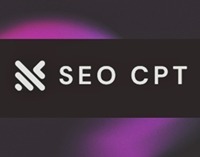
0 notes
Text

Be the first five businesses earning between 10M to 50M per year that SET UP a FREE BUSINESS DIGITAL & PROFIT MAXIMIZATION CONSULTATION & receive a FREE CUSTOMIZED LOGO & BRANDING CONSULTATION WORTH $1000.00!(Offer good until January 31, 2024)
BE THE FIRST FIVE READERS TO RECEIVE YOUR FREE CUSTOMIZED BUSINESS LOGO & FREE BRANDING CONSULTATION WORTH $1000 NOW! Visit:
www.AmericanElite.Biz
Offer Good Until January 31. 2024
The Transformative Role of Technology in Cosmetic Surgery
Putting Ideas into Pictures:
The consultation stage has been completely transformed by 3D imaging technologies, which offer a three-dimensional representation of possible results. Together, patients and surgeons can investigate options, promoting a better comprehension and well-informed choices.
Surgical Scheduling and Modeling:
Surgeons use three-dimensional imaging to plan surgeries with precision. Anatomical assessments, procedural simulations, and exact incision placement are made possible by this technology, which adds to a more precise and customized approach.
Improved Surgical Accuracy:
Precision has reached new levels thanks to robotically aided surgery. Surgeons possess unparalleled accuracy in performing intricate treatments, which results in less scarring, quicker recovery periods, and ultimately, happier patients.
Techniques with the Fewest Invasions:
Robotic systems are used for delicate treatments, allowing for minimally invasive techniques made possible by technology. This method not only makes sure that patients recuperate more comfortably, but it also presents cosmetic surgery as a less intrusive and more accessible choice.
Electronic Health Records:
EHR systems ensure accurate and conveniently accessible patient records by streamlining administrative duties. These digital data, which include treatment plans and medical histories, improve communication between healthcare providers and help ensure smooth patient care.
Improved Safety Procedures:
EHR systems that offer real-time access to patient data help to improve safety procedures. Comprehensive records enable surgeons to make well-informed decisions that minimize problems and guarantee patient safety.
Online Reach:
Geographical boundaries are removed through the use of telemedicine to permit remote consultations. Surgeons can now visit with patients in the convenience of their own homes, increasing access to cosmetic expertise and promoting a worldwide philosophy of beauty enhancement.
Simple Follow-Ups:
Telemedicine facilitates easier access to post-operative care. Virtual follow-ups allow surgeons to keep an eye on patients' recuperation and quickly address any issues, making the patient experience more convenient and tailored.
Keeping Digital Exchanges Safe:
As technology becomes more and more integrated into cosmetic surgery, strong cyber security protocols are essential. In the digital era, maintaining ethical standards, safeguarding privacy, and fostering trust are all facilitated by ensuring the safe handling of patient information.
Your call to action must have a deadline for an offer!—-Visit www.AmericanElite.biz
Be the first five businesses earning between 10M to 50M per year that SET UP a FREE BUSINESS DIGITAL & PROFIT MAXIMIZATION CONSULTATION & receive a FREE CUSTOMIZED LOGO & BRANDING CONSULTATION WORTH $1000.00!(Offer good until January 31, 2024)
BE THE FIRST FIVE READERS TO RECEIVE YOUR FREE CUSTOMIZED BUSINESS LOGO & FREE BRANDING CONSULTATION WORTH $1000 NOW! Visit:
www.AmericanElite.Biz
Offer Good Until January 31. 2024
#packaging#poster#programming#3d printing#rpg maker#typography#machine learning#python#software engineering
0 notes
Text
Unlocking the Essence of a Software Development Company: 3 Intriguing Facets
Dive into the dynamic world of software development as we unravel the fascinating layers of a Software Development Company. From cutting-edge technology to the art of innovation, explore three intriguing facets that define the essence of modern software development companies. Discover how they shape the digital landscape and revolutionize industries.
#machine learning#3d printing#lettering#linux#logo design#low poly#marketing#packaging#programming#poster#developer#software#software company#it services#web development#software development
0 notes
Text
Today's Adventure is that I, after an unintentional 13-hour power nap,
Got woken up at 6AM by a phone call from a friend stranded in Montana because of the heat wave and almost no cell service because of their crap provider.
OhSoThat'sHowIt'sGonnaBe.jpg
Ok.
I somehow summon a week's worth of spoons and in less than 30 minutes and 5 phone calls, get them
A hotel
An appointment with a mechanic from 2 states away
A perscription refilled from 2 states away
and A Pizza
Go me.
But then it's 8AM and there are unscheduled live humans at the door and while EVERGENCY MODE is still on, I have already blown through a ton of spoons, and also probably shouldn't meet whoever it is wearing just a pair of bootyshorts that say "CRYPTID" in Gothic Font on my ass.
So I greet them in those shorts and a T-shirt that I manage to put on both inside out and backwards
#nailedit
It is, Fortunately, not the mormons.
it is, Unfortunately, two UPS guys trying to deliver my other in-house friend's new phone except the new guy doesn't know how to operate the "sign for package" device, and the old guy that's supposed to be mentoring him is like, 92, deaf as a post, and doesn't actually know how to operate the device either.
by the way
it is already
over 100 out
it takes almost 30 minutes to sign for the phone
when i get back inside, i discover that apparently the Corgi has learned how to open his kennel from the inside because he is now out of the kennel and waiting for me to come in.
he also has cat litter all over his face because while he was waiting for me he also learned how to open the baby gate to the cat's room and help himself to a cat shit breakfast.
He'll be fine
He's a cattle dog, they're legally required to have at least 1 really disgusting snack they love.
but
more to the point
i have no idea at what point he learned to open his kennel from the inside
has he been staying there out of politeness this whole time??
And
I got other shit to do today.
namely.
I'm seeing a realator
The Devils most pathetic yet effective demons
I get a reminder text that I have an appointment with her
at least
I think that's what it is because what she sends me is:
"🏡⏰12:00 ❔"
With the time typed in the middle like that.
She is, according to her profile, at least 80.
so I reply "😎👍"
and then she sends me a string of GODDAMN POST-MODERN EMOJI HEIROGLYPHICS THAT TAKE UP MY ENTIRE SCREEN.
She's on an iPhone so half of them don't even translate across platforms
It takes me half an hour and three different software programs and goddamn wingdings to translate, but she has sent me the address and rules about masking and not wearing shoes inside.
in emoji
instead of like
literally any other format
I am
FASCINATED
and simply must meet the woman so if I don't come back to update I got stolen by the fairies but I'm taking the Corgi with me as protection so I'll see y'all later.
111K notes
·
View notes
Text

#Best Premiere Pro Video Editing Course in Delhi.#With video editing courses#you can learn to use software such as Adobe Premiere Pro to enhance visual works. Expert professionals can teach you techniques for manipul#you will learn Step wise step à Video Editing Options. You will do Practical on Job work Content. after it how to make Social Media Reel#Animated Text#Videos#Intro Video Ads#Opportunity: You Can Get a Free Internship for 3-6 Months (Offline/Online) Get Experience Certificate after Complete Internship.#Work Profile: after learning you can get a Job of Video Editing#work as a Freelancer#or Start your own Video Editing Company.#(Video Editing Course)#Covered Content: – Adobe Premier#Basic Hindi Typing Knowledge#Internet Course#Duration: 01 Months (Daily Batch: Mon to Fri) Course Package Fee: Rs.3000/-#Admission Fee:-300 /-#Total Course Fee:-3600 /- Monthly Fees: 1500/- Pm.#Final Examination Fee: – 300 /-#[Course Certificate will provide after 15 Days]
0 notes
Text
Software Development Companies USA
Paradise TechSoft Solutions Pvt. Ltd. directed by Amit Kumar and Puneet Kaushal. We are a team of creative thinkers, makers, explorers etc that brings a wealth of experience in best it companies in usa and constantly sharp learning about top software development companies in usa and challenges new creativities around best it companies in usa.
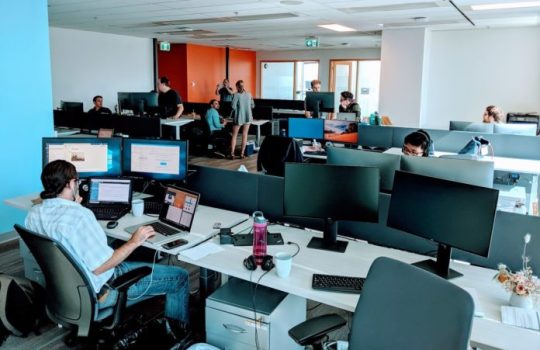
Our developers always begin by considering a client’s website objectives. We do appreciate every aspect matters when you want to sell effectively, based on your store implementation we utilize our e-commerce insight. Front-end web development is not design but a front-end developer does apply the design of the designers to the web pages to translate their well-designed layouts into the real code. To understand the back-end language or the server-side, you should know about the front-end and how they both interacts.
#software development companies usa#software companies in usa#top software development companies in usa#top it services companies in usa#it services company in usa#best it companies in usa#machine learning services usa#artificial intelligence services usa#affordable development packages usa#web development agencies in usa#professional development services usa#top development services USA
0 notes
Text
Inspired by my lovely mutual @shotmrmiller and a second submission to #Soapitup (im summonimg you again @glitterypirateduck ). Im actually going to name this one and it’s called:
A doll and his loser.
Its loser!reader x sex doll!Reboot!Soap
Masterlist is pinned on profile as always, don’t forget to leave me a comment or a request in my inbox to let me know what yall want to see!
Especially let me know if you want part two
Fic under the cut as always.
Edit: im incredibly dyslexic im so sorry for typos
When the line of 141 sex dolls, which were based on random men she had never heard of who seemed just magically created for this line, showed in a sketching email in her inbox, she must have been truly weak that night. She had been incredibly drunk and disappointed by a man who just didn’t even bother to bring her pleasure. So of course she ordered the sketchy, ‘satisfaction guaranteed’ doll. There were choices, quite a few actually. But it was the beefy Scottsman that stood out against the rest, she couldn’t tell you why. Maybe it was his soft face, his muscles, or maybe the outfit he came with, it could even be his hair. Sure there was a photo of what his cock looked like on the sight, a normal length with a great amount of girth, but she wasn’t too picky.
She had completely forgotten about the lifelike sex doll she ordered, she learned was named ‘Johnny’ until the giant box that weighed more than she did sat on her doorstep. She quickly shoved the package marked ‘fragile’ in her door. The gibberish language on the side of the box wasn’t one she recognized, she realized as she struggled to get the box in. She gently put the box on its side before grabbing a butter knife from her kitchen.
When she got the sides of the box open she saw his face. So much softer in person, with his long lashes and plush cheeks. She traced her thumb over his cheek and over his lips before his eyes gently fluttered open at her touch. He seemed almost surprised before his eyes relaxed. It must be the personality software? It did say something about that. His eyes a crazy blue, the kind that looks like the ocean meeting the sky, they were so glossy and sweet, they seemed, truthfully, real. She brushed it off, its just a doll, this was a high tech sex doll, at least that's what the marketing said.
He studied her features and watched to lean into her warm touch, but his rigid body wouldn’t allow it.
She did her best to get the heavy doll out of its box. Dragging it into her bedroom. Even his hair is life-like, which was crazy.
When she got him onto her bed she propped him up against the headboard of her bed, his eyes watching her every move as she walked back out to search for his manual.
“Stupid company didn’t even send me a manual.” She grumbled, a few things were written on the box.
‘Ejaculates like a real man!’ ‘Life-like groans!’ ‘Tease him to get him up!’ ‘Built like a real stallion!’ There was a forth thing that the words had pulled off of when she tore off the tape, now it was illegible but she saw it pointed to the lips, so she assumed they were ‘soft like a real man’s!’
He was almost static in whatever position she put him in, one of his arms hovering in the weird position she left it in.
He seemed almost too lifelike, the way his eyes watched her.
“What?” She asked, “you seem surprised.”
She was met with silence.
“Oh, who am I kidding, you’re a fucking doll. You’re not going to reply to me, this isn’t some X rated Toy Story movie.” She grumbled before her stomach grumbled back. So she left her doll man to get some food.
She cooked herself a quick meal then went to go shower, completely forgetting about the doll as she stripped until she noticed the large bump in his change.
“I didn’t realize stripping to shower meant teasing,” she thought out loud. “At least now I can check if you were marketed correctly.”
She gently undid the belt on the doll’s pants, which seemed like real high quality jeans a real person would wear, before undoing the button and the zipper. Sliding down the waistband of his underwear she noticed the monster.
Her eyes flew wide, “maybe I should ask for measurements next time,” she mumbled, she wanted to faint. “They didn’t tell me you had a horse cock, big guy,’ she chuckled to herself, his eyes almost looking prideful, pupils seeming larger with almost bedroom eyes. They must have some crazy tech.
“I must really be losing it, talking to myself,” she sighed.
She let her fingers gently graze his dick before she spit on her hand, she wrapped her fingers around his fat cock delicately, not reaching all the way around. She sighed before getting up to pull more lube from her night stand. One of her hands, now covered in lube, began to massage him while her other hand began to rub around her pussy.
She hummed, mumbling about how needy she was, how guys had disappointed her in the past, what she wanted. This went on for a few minutes until she was sure she was prepped, awkwardly climbing on top of her beefcake sex doll before lining him up with her hole and sinking down. His eyes rolled back but she didn’t notice because her’s did too.
“Oh fuck,” she mumbled almost pitifully, letting her head fall against his hairy chest, a tattoo of a Scottish flag pulled tight on one of his pecs. “I haven’t been filled like this in so long.”
She sat there and adjusted, hands balled into fists against the doll’s chest. A chest that felt so warm and inviting.
She slowly began to rock her hips, soft whimpers and moans falling from her lips that got louder as she began to bounce on him. She supported herself with one hand while the other was in her mouth to suffocate her louder moans. Her eyes teary from the girth of him.
The doll let out little groans and moans too that slipped from behind his sealed lips.
It wasn’t long before her tight walls began to flutter, he came almost instantly when they began to flutter, she gasped at the feeling but kept going until she reached her own peak. But it wasn’t quite enough, so she kept bouncing. He came faster and faster, cock starting to ache because of the bonnie lass that was riding it. With a cunt like that on him he couldn’t help but shoot hot, white spirts into her.
When she got off him, it slid down her inner thigh, she swiped it up and stuck it in her mouth which made him almost faint.
“Jeez, it tastes real too,” she said like a question before walking away.
She got a wash cloth she had been planning to use for a shower and cleaned up the dolly with gentle touches. She felt like she needed to treat him like a real man, he was so close it seemed. She zipped his pants back up and set him on the ground before putting a sleep mask over his eyes.
“Nothing personal, I just don’t know how to put you in sleep mode and I don’t want to accidentally turn your dick on again when I get out of the shower.” She said before hopping in the bathroom. Her pussy was sore to say the least, but the good kind, the kind that makes a girl feel well used and fulfilled, she did her best to get the most of that fake cum out of her cunt.
After she scrubbed herself clean of the day and of that fulfilling session with her doll she made her way back into her room and flopped on her bed before crashing and falling asleep.
She used him about every other day or so for the next couple weeks before she started ovulating. She was like a bitch in heat, her body couldn’t calm down. She was flushed and couldn’t stop. She had two days off from work and pulled Johnny from where he had been set on the chair, returning him to her bed. The weird doll must have realized something weird was happening because it- he- was immediately hard. She immediately got on too of him, she had tried other positions but cowgirl was just the easiest by far with Johnny. She immediately lubed herself and him up, pumping him twice to make sure he was fully hard before sliding on.
The broken moans that fell from her mouth were a chorus of angels singing in his ears.
“I feel like such a loser,” she whined, “talking to and fucking a sex doll instead of a real guy, i feel like a weirdo.”
She put her head to his chest with whimpers falling from her mouth. He had already cum, his noises turning to the broken ones they always did before he came, a nice audio cue for the doll to have.
“Just a little more, please,” she whined to her doll.
After she rode out her high she laid sprawled out against his chest.
“I wonder how you’d be im bed if you were real,” she asked no one in particular. She was so especially weak right now. Ovulation making her so needy and sad, she couldn’t help but place a gentle kiss to his stiff lips as she let her eyes flutter closed to take a breather before the horny took back over.
She didn’t feel his stiff body relax, she didn’t notice anything until his plastic-y fingers ran up and down her waist.
“You won’t have to wonder any more, bonnie lass.” His voice was a low grumble in here ear, his scottish accent loud and clear. “How do you want it, I’m going to take good care of you.”
Hope you have a wonderful day, lovely reader💜 you deserve it
ALSO SIMON’S IS UP NOW.
#cod x reader#call of duty#soapitup#john soap mctavish x reader#soap mactavish x reader#soap mactavish#soap call of duty#soap mw2#soap x reader#soap cod
402 notes
·
View notes
Text
wrixie's guide to default eyes 🤩
welcome to my guide on making default eye colors for the sims 4
this'll be my first ever tutorial and it's a big one so please bear with me!
if you have any questions please don't be afraid to send me a message!
here you will hopefully learn how to: make defaults for humans, aliens and vampires as well as cats, dogs and mini goats and sheep!
-> i'm unsure about how to do cottage living animals anymore due to s4s changing and the foxes are currently bugged to be gray :( BUT i will provide my files so you can just recolor them and merge them back together down below
you will need a few things to start:
sims4studio, photo editing software such as gimp or photoshop to create and edit your textures, some meshes that i've provided + these body templates
human defaults (and beginning steps):
open up sims4studio, locate the CAS button, under that you should have 'override' ticked instead of the default 'create CAS standalone' then click the big CAS button to go to the next step
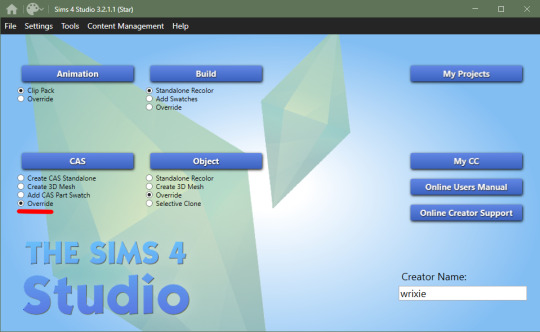
2. you'll see a few drop down menus, locate 'Part Type:', scroll down until you find 'Eye Color', we're doing human eyes so shift+click all of the base game default colors and click next
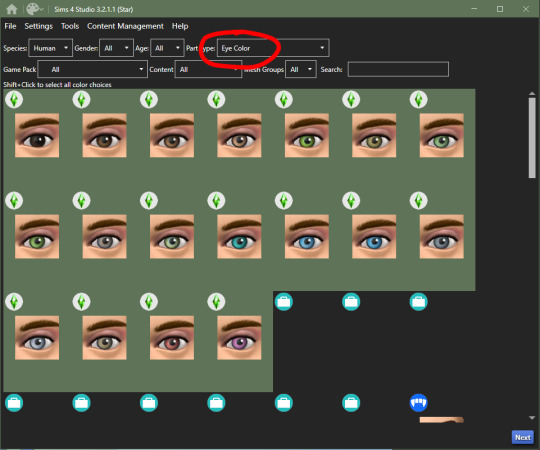
3. save your new .package file what ever you please i recommend something like -> yourname_eyename_default <- make sure to have it save into your mods folder or somewhere where you can easily access it (i saved mine into my mods folder)
4. this is where you'll import all your eye colors - assuming you've made your eye textures, locate the 'Texture' box in the 'Texture' panel, you'll see three maps: Diffuse, Shadow + Specular, import your eye texture in the 'Diffuse' texture for all of your eye colors, click on 'Specular' then click on the purple 'Make Blank' button to get rid of the cloudy shine on the default eyes (you'll have to do this manually for each swatch)


alien eyes:
you'll do the same as the human in terms of selecting 'override' in the CAS section then locate 'Part Type:', scroll down until you find 'Eye Color', but instead of selecting the human eyes, we'll select the all of the alien eyes with shift+click - they don't have previews for some reason

2. then you can follow the previous steps, save your file under yourename_eyename_aliens_default into your mods folder
3. same as the humans, import all of your alien eyes into their proper swatches but this time there's two more maps: Normal + Emission - you do not need to touch these for aliens as alien eyes do not glow and the emission map is for glowing textures (i have no idea how to do this)
4. make your 'Specular' maps blank and click save!
vampire eyes:
do the same as the others in terms of selecting 'override' in the CAS section of the main menu, locate 'Part Type:', scroll down until you find 'Eye Color', but instead of selecting the all of the human/alien eyes, we'll be selecting the black swatch for right now - this black swatch is for all ages
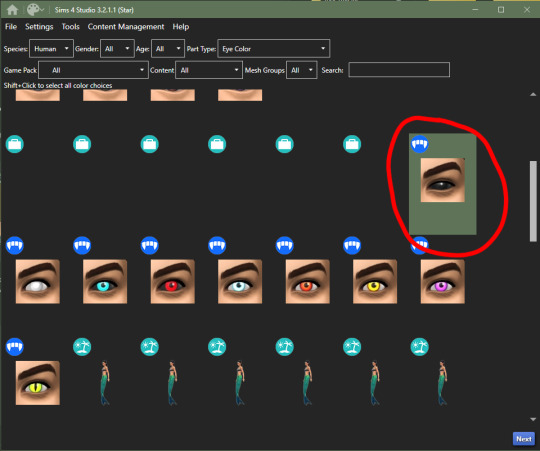
2. import your black swatch in 'Diffuse' and make the 'Specular' blank
3. this is where you can veer off and follow a different tutorial to get the glow of the vampire eyes or you can continue without it here; go into your photo editing software, create a 1024x2048 image and fill it in completely with black and save it as emission (this is what you'll use to lose the glow and make the eyes work)
4. in the 'Texture' panel, go to 'Emission' and import your black image you just made and save it as -> yourname_eyename_vampires_black < (or what have you)
5. now change the 'Age: All' to 'Adult', select the next eye color, save it as the color it is and follow steps 2 - 4
6. after completing all of your adult swatches, change 'Age: Adult' to 'Child' and repeat the steps you just took with each eye color you will have to do the same with toddler and infant eyes as well; save child files with _CU in the file name, _PU for toddlers and _infants for ya know... infants
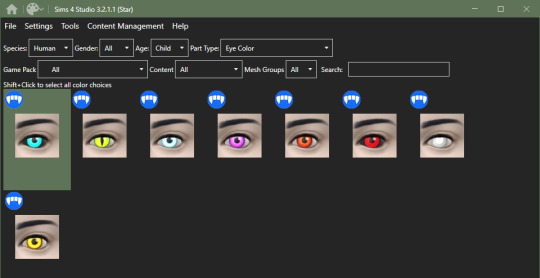
7. once you have all your swatches done, make sure to test them before this next step (merging the files into one, this is an optional step but highly recommended) go back to the main menu and under 'Content Management' click 'Merge Packages..'

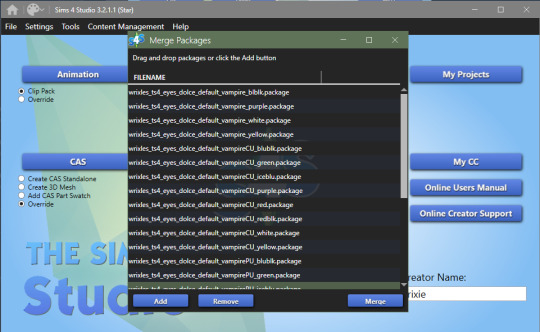
8. click 'Add' and select all of your vampire eye files, click 'Merge' and name it what you want
cats & dogs:
with sims4studio open, the CAS section should still have 'override' ticked, click CAS again and in the drop down menus, change 'Species: Human' to Large Dog, Small Dog, Cat, Foxes, or Horses; if you don't have the textures already, export the default texture so you have it as a base

2. import each of your textures in the 'Diffuse' map and make your 'Specular' map blank for each color and save
3. for heterochromia you can use these meshes - edit the textures to add your own, import your texture to the 'Diffuse' map and make your 'Specular' map blank for each color and save as _heterochromia
4. remember to test before merging - go back to the main menu and under 'Content Management' click 'Merge Packages..', add your files and merge them
mini goats & sheep:
in the Object section of the main menu, tick 'override' and click the Object button

2. in the 'Game Pack' drop down menu, choose 'Horse Ranch' and tick 'Show Debug Items' and at the very top, you should see the mini goat, select this and click next save it as what you would like to
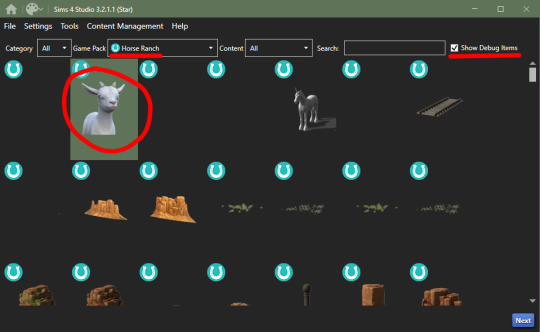
3. go into the 'Texture' tab and export all the goats textures if you haven't already made your eyes - when you have your textures done, import them into the 'Diffuse' map for each swatch and save

4. go back to the main menu and repeat steps 1 + 2 but instead of selecting the mini goats, scroll down until you see the mini sheep, should only be a tick or two down and then repeat step 3
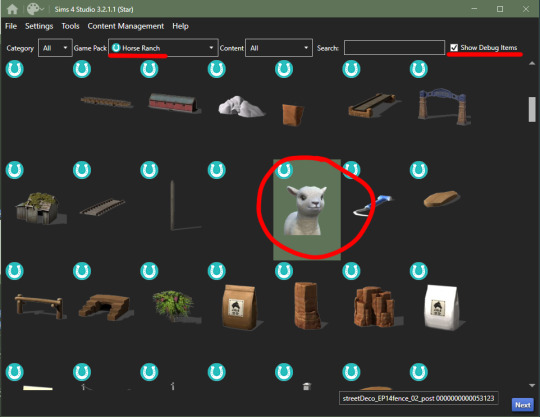
cottage living:
go to my folder and download the meshes you need here i'll go through recoloring each animal, we're going to start with the wild rabbits; open the rabbits file
ignore the top file you don't need to edit this
'Export' (not the batch export) each rabbit texture, open them up in your photo editor and add your own eye texture then 'Import' each of them in their proper swatch and save
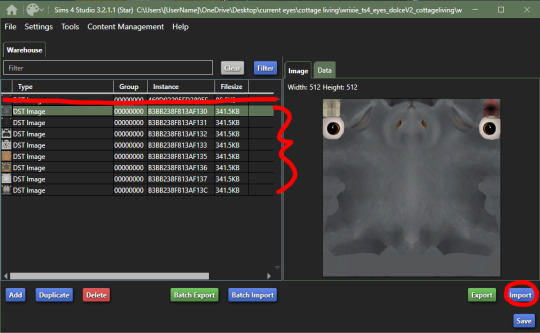
next will be the llamas, open up the file, you might be put into the 'Warehouse' tab, switch over to the 'Studio' tab
export all the 'Diffuse' textures of each swatch, open them up in your photo editor and add your own eye texture then 'Import' each of them in their proper swatch and save
cows are next, open up the file, ignore the top file and 'Export' the three textures then edit them in your photo editor to add your own eyes
'Import' each swatch in their proper place and save

lastly, for now, are the chickens, open up the file in sims4studio, 'Export' the first 6 image files, ignore the next 2, then export then last 5 and repeat editing and adding your own eye textures to them
once that's done, 'Import' all your swatches in their proper places and save

how to convert non-defaults/contacts to default:
1. open up sims4studio, locate the CAS button, under that you should have 'override' ticked instead of the default 'create CAS standalone'
2. before clicking on the CAS button, go to My Projects and open up the contacts you want to make default and 'Export' each color to save it on your computer
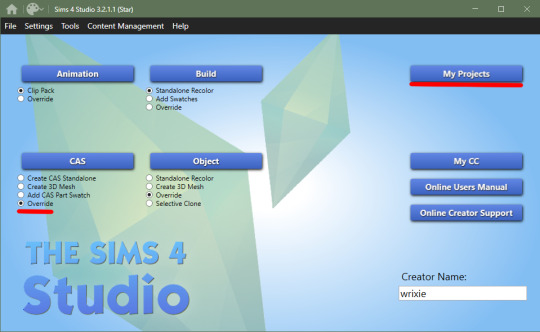
3. now you're going to basically follow the beginning steps again, go back to the main menu and click the big CAS button, then it's 'Part Type: Eye Color', shift+click all human eyes or vampire or alien eyes and hit next (i'll be doing human eyes) if you were put into the 'Warehouse' tab switch over to the 'Studio' tab.
4. 'Import' your textures to each swatch to the 'Diffuse' map and make the 'Specular' blank and save!
181 notes
·
View notes
Text
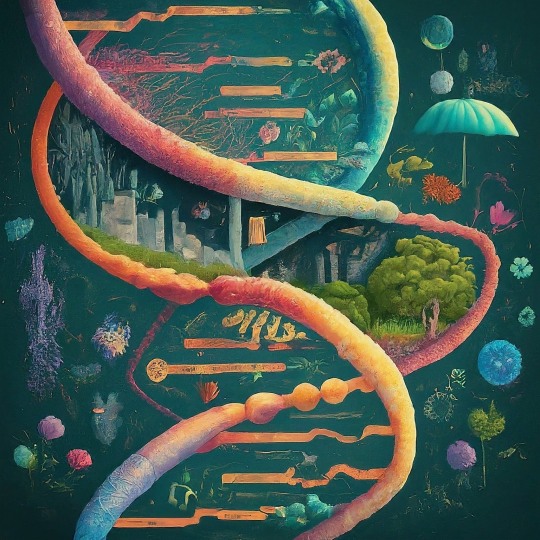
Epigenetics: A Journey Through Inheritance Beyond Genes
For centuries, scientists have been fascinated by the mysteries of heredity and how traits are passed down from generation to generation. DNA, the molecule that stores our genetic code, was once thought to be the sole determinant of our characteristics. However, a new frontier in biology, revealing a captivating layer of complexity beyond the DNA sequence itself: Epigenetics.
What is Epigenetics?
The term "epigenetics" was first coined in the 1940s by British biologist Conrad Waddington, but it wasn't until the late 20th century that its significance truly blossomed. Epigenetics, literally meaning "above genetics," refers to the study of heritable changes in gene expression that occur without alterations to the DNA sequence itself. Imagine DNA as the musical score, but epigenetics are the conductor and musicians who determine how the music is played. Through chemical modifications and adjustments to the proteins around DNA, epigenetics dictates which genes are turned on or off, influencing how cells function and ultimately shaping our health, development, and even behavior. Think of your DNA as the hardware: it contains the basic instructions for building and running your body. But epigenetics acts like the software, fine-tuning those instructions and determining which genes get turned on or off at specific times and in specific cells. These modifications, like chemical tags or changes in the packaging of DNA, don't alter the underlying code itself, but they can have a profound impact on how it's read and interpreted.
The Key Players:
DNA methylation: This process involves adding a methyl group to DNA, essentially silencing the gene it's attached to. Imagine it like putting a dimmer switch on a light bulb.
Histone modifications: Histones are proteins that package DNA, and changes in their structure can make genes more or less accessible to the cellular machinery needed for expression. Think of it like adjusting the curtains around a window - open wide for full light, slightly closed for filtered light.
Non-coding RNAs: These are molecules that don't code for proteins but can regulate gene expression in various ways. They're like the backstage crew in a play, ensuring everything runs smoothly.
The Power of Epigenetic Regulation
Epigenetic regulation plays a crucial role in various biological processes, including:
Development: During embryonic development, different cell types emerge from the same DNA blueprint by activating or silencing specific gene sets through epigenetic modifications.
Cellular differentiation: Specialized cells like muscle or nerve cells have unique functions due to differences in their active genes, controlled by epigenetic mechanisms.
Learning and memory: Epigenetic changes in brain cells are thought to be essential for learning and forming memories.
Aging: As we age, our epigenome accumulates changes that can contribute to age-related decline and disease.
Environmental influences: Diet, exercise, stress, and exposure to toxins can leave epigenetic marks on our genes, potentially impacting our health and even the health of future generations.
Epigenetics reminds us that we are not simply products of our genes. Our environment, choices, and experiences leave their mark, shaping who we are and potentially influencing our children's health. This deeper understanding of ourselves opens doors for self-awareness, empowerment, and potentially reshaping our narratives – not just as individuals, but as a species with the potential to leave a healthier legacy for generations to come.
#life science#biology#science sculpt#molecular biology#biotechnology#epigenetics#daily dose of science#dna#genetic inheritance#genetics#decoding dna#genetic code#science#double helix
103 notes
·
View notes
Text
"Open" "AI" isn’t

Tomorrow (19 Aug), I'm appearing at the San Diego Union-Tribune Festival of Books. I'm on a 2:30PM panel called "Return From Retirement," followed by a signing:
https://www.sandiegouniontribune.com/festivalofbooks

The crybabies who freak out about The Communist Manifesto appearing on university curriculum clearly never read it – chapter one is basically a long hymn to capitalism's flexibility and inventiveness, its ability to change form and adapt itself to everything the world throws at it and come out on top:
https://www.marxists.org/archive/marx/works/1848/communist-manifesto/ch01.htm#007
Today, leftists signal this protean capacity of capital with the -washing suffix: greenwashing, genderwashing, queerwashing, wokewashing – all the ways capital cloaks itself in liberatory, progressive values, while still serving as a force for extraction, exploitation, and political corruption.
A smart capitalist is someone who, sensing the outrage at a world run by 150 old white guys in boardrooms, proposes replacing half of them with women, queers, and people of color. This is a superficial maneuver, sure, but it's an incredibly effective one.
In "Open (For Business): Big Tech, Concentrated Power, and the Political Economy of Open AI," a new working paper, Meredith Whittaker, David Gray Widder and Sarah B Myers document a new kind of -washing: openwashing:
https://papers.ssrn.com/sol3/papers.cfm?abstract_id=4543807
Openwashing is the trick that large "AI" companies use to evade regulation and neutralizing critics, by casting themselves as forces of ethical capitalism, committed to the virtue of openness. No one should be surprised to learn that the products of the "open" wing of an industry whose products are neither "artificial," nor "intelligent," are also not "open." Every word AI huxters say is a lie; including "and," and "the."
So what work does the "open" in "open AI" do? "Open" here is supposed to invoke the "open" in "open source," a movement that emphasizes a software development methodology that promotes code transparency, reusability and extensibility, which are three important virtues.
But "open source" itself is an offshoot of a more foundational movement, the Free Software movement, whose goal is to promote freedom, and whose method is openness. The point of software freedom was technological self-determination, the right of technology users to decide not just what their technology does, but who it does it to and who it does it for:
https://locusmag.com/2022/01/cory-doctorow-science-fiction-is-a-luddite-literature/
The open source split from free software was ostensibly driven by the need to reassure investors and businesspeople so they would join the movement. The "free" in free software is (deliberately) ambiguous, a bit of wordplay that sometimes misleads people into thinking it means "Free as in Beer" when really it means "Free as in Speech" (in Romance languages, these distinctions are captured by translating "free" as "libre" rather than "gratis").
The idea behind open source was to rebrand free software in a less ambiguous – and more instrumental – package that stressed cost-savings and software quality, as well as "ecosystem benefits" from a co-operative form of development that recruited tinkerers, independents, and rivals to contribute to a robust infrastructural commons.
But "open" doesn't merely resolve the linguistic ambiguity of libre vs gratis – it does so by removing the "liberty" from "libre," the "freedom" from "free." "Open" changes the pole-star that movement participants follow as they set their course. Rather than asking "Which course of action makes us more free?" they ask, "Which course of action makes our software better?"
Thus, by dribs and drabs, the freedom leeches out of openness. Today's tech giants have mobilized "open" to create a two-tier system: the largest tech firms enjoy broad freedom themselves – they alone get to decide how their software stack is configured. But for all of us who rely on that (increasingly unavoidable) software stack, all we have is "open": the ability to peer inside that software and see how it works, and perhaps suggest improvements to it:
https://www.youtube.com/watch?v=vBknF2yUZZ8
In the Big Tech internet, it's freedom for them, openness for us. "Openness" – transparency, reusability and extensibility – is valuable, but it shouldn't be mistaken for technological self-determination. As the tech sector becomes ever-more concentrated, the limits of openness become more apparent.
But even by those standards, the openness of "open AI" is thin gruel indeed (that goes triple for the company that calls itself "OpenAI," which is a particularly egregious openwasher).
The paper's authors start by suggesting that the "open" in "open AI" is meant to imply that an "open AI" can be scratch-built by competitors (or even hobbyists), but that this isn't true. Not only is the material that "open AI" companies publish insufficient for reproducing their products, even if those gaps were plugged, the resource burden required to do so is so intense that only the largest companies could do so.
Beyond this, the "open" parts of "open AI" are insufficient for achieving the other claimed benefits of "open AI": they don't promote auditing, or safety, or competition. Indeed, they often cut against these goals.
"Open AI" is a wordgame that exploits the malleability of "open," but also the ambiguity of the term "AI": "a grab bag of approaches, not… a technical term of art, but more … marketing and a signifier of aspirations." Hitching this vague term to "open" creates all kinds of bait-and-switch opportunities.
That's how you get Meta claiming that LLaMa2 is "open source," despite being licensed in a way that is absolutely incompatible with any widely accepted definition of the term:
https://blog.opensource.org/metas-llama-2-license-is-not-open-source/
LLaMa-2 is a particularly egregious openwashing example, but there are plenty of other ways that "open" is misleadingly applied to AI: sometimes it means you can see the source code, sometimes that you can see the training data, and sometimes that you can tune a model, all to different degrees, alone and in combination.
But even the most "open" systems can't be independently replicated, due to raw computing requirements. This isn't the fault of the AI industry – the computational intensity is a fact, not a choice – but when the AI industry claims that "open" will "democratize" AI, they are hiding the ball. People who hear these "democratization" claims (especially policymakers) are thinking about entrepreneurial kids in garages, but unless these kids have access to multi-billion-dollar data centers, they can't be "disruptors" who topple tech giants with cool new ideas. At best, they can hope to pay rent to those giants for access to their compute grids, in order to create products and services at the margin that rely on existing products, rather than displacing them.
The "open" story, with its claims of democratization, is an especially important one in the context of regulation. In Europe, where a variety of AI regulations have been proposed, the AI industry has co-opted the open source movement's hard-won narrative battles about the harms of ill-considered regulation.
For open source (and free software) advocates, many tech regulations aimed at taming large, abusive companies – such as requirements to surveil and control users to extinguish toxic behavior – wreak collateral damage on the free, open, user-centric systems that we see as superior alternatives to Big Tech. This leads to the paradoxical effect of passing regulation to "punish" Big Tech that end up simply shaving an infinitesimal percentage off the giants' profits, while destroying the small co-ops, nonprofits and startups before they can grow to be a viable alternative.
The years-long fight to get regulators to understand this risk has been waged by principled actors working for subsistence nonprofit wages or for free, and now the AI industry is capitalizing on lawmakers' hard-won consideration for collateral damage by claiming to be "open AI" and thus vulnerable to overbroad regulation.
But the "open" projects that lawmakers have been coached to value are precious because they deliver a level playing field, competition, innovation and democratization – all things that "open AI" fails to deliver. The regulations the AI industry is fighting also don't necessarily implicate the speech implications that are core to protecting free software:
https://www.eff.org/deeplinks/2015/04/remembering-case-established-code-speech
Just think about LLaMa-2. You can download it for free, along with the model weights it relies on – but not detailed specs for the data that was used in its training. And the source-code is licensed under a homebrewed license cooked up by Meta's lawyers, a license that only glancingly resembles anything from the Open Source Definition:
https://opensource.org/osd/
Core to Big Tech companies' "open AI" offerings are tools, like Meta's PyTorch and Google's TensorFlow. These tools are indeed "open source," licensed under real OSS terms. But they are designed and maintained by the companies that sponsor them, and optimize for the proprietary back-ends each company offers in its own cloud. When programmers train themselves to develop in these environments, they are gaining expertise in adding value to a monopolist's ecosystem, locking themselves in with their own expertise. This a classic example of software freedom for tech giants and open source for the rest of us.
One way to understand how "open" can produce a lock-in that "free" might prevent is to think of Android: Android is an open platform in the sense that its sourcecode is freely licensed, but the existence of Android doesn't make it any easier to challenge the mobile OS duopoly with a new mobile OS; nor does it make it easier to switch from Android to iOS and vice versa.
Another example: MongoDB, a free/open database tool that was adopted by Amazon, which subsequently forked the codebase and tuning it to work on their proprietary cloud infrastructure.
The value of open tooling as a stickytrap for creating a pool of developers who end up as sharecroppers who are glued to a specific company's closed infrastructure is well-understood and openly acknowledged by "open AI" companies. Zuckerberg boasts about how PyTorch ropes developers into Meta's stack, "when there are opportunities to make integrations with products, [so] it’s much easier to make sure that developers and other folks are compatible with the things that we need in the way that our systems work."
Tooling is a relatively obscure issue, primarily debated by developers. A much broader debate has raged over training data – how it is acquired, labeled, sorted and used. Many of the biggest "open AI" companies are totally opaque when it comes to training data. Google and OpenAI won't even say how many pieces of data went into their models' training – let alone which data they used.
Other "open AI" companies use publicly available datasets like the Pile and CommonCrawl. But you can't replicate their models by shoveling these datasets into an algorithm. Each one has to be groomed – labeled, sorted, de-duplicated, and otherwise filtered. Many "open" models merge these datasets with other, proprietary sets, in varying (and secret) proportions.
Quality filtering and labeling for training data is incredibly expensive and labor-intensive, and involves some of the most exploitative and traumatizing clickwork in the world, as poorly paid workers in the Global South make pennies for reviewing data that includes graphic violence, rape, and gore.
Not only is the product of this "data pipeline" kept a secret by "open" companies, the very nature of the pipeline is likewise cloaked in mystery, in order to obscure the exploitative labor relations it embodies (the joke that "AI" stands for "absent Indians" comes out of the South Asian clickwork industry).
The most common "open" in "open AI" is a model that arrives built and trained, which is "open" in the sense that end-users can "fine-tune" it – usually while running it on the manufacturer's own proprietary cloud hardware, under that company's supervision and surveillance. These tunable models are undocumented blobs, not the rigorously peer-reviewed transparent tools celebrated by the open source movement.
If "open" was a way to transform "free software" from an ethical proposition to an efficient methodology for developing high-quality software; then "open AI" is a way to transform "open source" into a rent-extracting black box.
Some "open AI" has slipped out of the corporate silo. Meta's LLaMa was leaked by early testers, republished on 4chan, and is now in the wild. Some exciting stuff has emerged from this, but despite this work happening outside of Meta's control, it is not without benefits to Meta. As an infamous leaked Google memo explains:
Paradoxically, the one clear winner in all of this is Meta. Because the leaked model was theirs, they have effectively garnered an entire planet's worth of free labor. Since most open source innovation is happening on top of their architecture, there is nothing stopping them from directly incorporating it into their products.
https://www.searchenginejournal.com/leaked-google-memo-admits-defeat-by-open-source-ai/486290/
Thus, "open AI" is best understood as "as free product development" for large, well-capitalized AI companies, conducted by tinkerers who will not be able to escape these giants' proprietary compute silos and opaque training corpuses, and whose work product is guaranteed to be compatible with the giants' own systems.
The instrumental story about the virtues of "open" often invoke auditability: the fact that anyone can look at the source code makes it easier for bugs to be identified. But as open source projects have learned the hard way, the fact that anyone can audit your widely used, high-stakes code doesn't mean that anyone will.
The Heartbleed vulnerability in OpenSSL was a wake-up call for the open source movement – a bug that endangered every secure webserver connection in the world, which had hidden in plain sight for years. The result was an admirable and successful effort to build institutions whose job it is to actually make use of open source transparency to conduct regular, deep, systemic audits.
In other words, "open" is a necessary, but insufficient, precondition for auditing. But when the "open AI" movement touts its "safety" thanks to its "auditability," it fails to describe any steps it is taking to replicate these auditing institutions – how they'll be constituted, funded and directed. The story starts and ends with "transparency" and then makes the unjustifiable leap to "safety," without any intermediate steps about how the one will turn into the other.
It's a Magic Underpants Gnome story, in other words:
Step One: Transparency
Step Two: ??
Step Three: Safety
https://www.youtube.com/watch?v=a5ih_TQWqCA
Meanwhile, OpenAI itself has gone on record as objecting to "burdensome mechanisms like licenses or audits" as an impediment to "innovation" – all the while arguing that these "burdensome mechanisms" should be mandatory for rival offerings that are more advanced than its own. To call this a "transparent ruse" is to do violence to good, hardworking transparent ruses all the world over:
https://openai.com/blog/governance-of-superintelligence
Some "open AI" is much more open than the industry dominating offerings. There's EleutherAI, a donor-supported nonprofit whose model comes with documentation and code, licensed Apache 2.0. There are also some smaller academic offerings: Vicuna (UCSD/CMU/Berkeley); Koala (Berkeley) and Alpaca (Stanford).
These are indeed more open (though Alpaca – which ran on a laptop – had to be withdrawn because it "hallucinated" so profusely). But to the extent that the "open AI" movement invokes (or cares about) these projects, it is in order to brandish them before hostile policymakers and say, "Won't someone please think of the academics?" These are the poster children for proposals like exempting AI from antitrust enforcement, but they're not significant players in the "open AI" industry, nor are they likely to be for so long as the largest companies are running the show:
https://papers.ssrn.com/sol3/papers.cfm?abstract_id=4493900

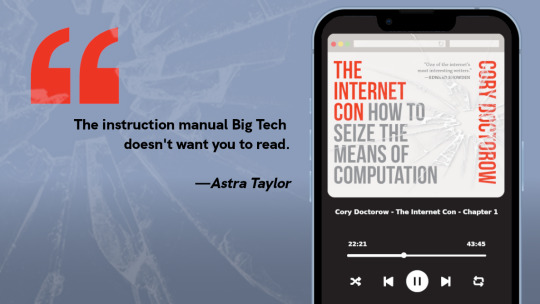
I'm kickstarting the audiobook for "The Internet Con: How To Seize the Means of Computation," a Big Tech disassembly manual to disenshittify the web and make a new, good internet to succeed the old, good internet. It's a DRM-free book, which means Audible won't carry it, so this crowdfunder is essential. Back now to get the audio, Verso hardcover and ebook:
http://seizethemeansofcomputation.org

If you'd like an essay-formatted version of this post to read or share, here's a link to it on pluralistic.net, my surveillance-free, ad-free, tracker-free blog:
https://pluralistic.net/2023/08/18/openwashing/#you-keep-using-that-word-i-do-not-think-it-means-what-you-think-it-means

Image:
Cryteria (modified)
https://commons.wikimedia.org/wiki/File:HAL9000.svg
CC BY 3.0
https://creativecommons.org/licenses/by/3.0/deed.en
#pluralistic#llama-2#meta#openwashing#floss#free software#open ai#open source#osi#open source initiative#osd#open source definition#code is speech
250 notes
·
View notes
Text
Online aesthetics and the effects of social media trends


Let's talk about this.
How it can affect young teenagers
Open Tiktok or Instagram and everything on my For You Page now shows "How to achieve a Clean Girl Aesthetic"', "Old Money Aesthetic Hairstyles", "Cottagecore Hobbies", "How to be a Femme Fatale"
It never ends. Trends keep popping up left and right and it's inescapable.
As a young, impressionable teenager, I was, of course, naturally going to be influenced by these ever-changing trends. I'd constantly change my room aesthetic, buy new clothes, and I was never satisfied with my appearance. Why? Because I didn't look like the girls on screen.
News flash. You're never going to look like them. All that content they produce which gets 100k likes is done with excessive attention to detail, expensive lighting and sound equipment, and top-notch editing software. OF COURSE, you can't look like that. It's completely manufactured. It's heartbreaking to see young girls develop body image issues because of the constant bombarding of these "aesthetics" which are basically different beauty standards and stereotypes all wrapped up in a neat little package that is labelled "personality and style". I don't have anything against the concepts of aesthetics. I love how Dark and Light Academia is centred around learning, and how Cottagecore is all about relaxation and not conforming to being part of a 9-5 and just living life. I like how the Clean Girl is focused on being healthy and productive. What I don't like is how all these healthy things, which normal functioning humans should be doing are now turned into "trends" and you must "choose" between them.
Why it's so harmful
Fashion: Since aesthetics keep changing, you're going to find multiple that appeal to you. What happens when you discover you really like cottagecore, but your closet is filled with dark academia tweed? You turn to fast fashion. It's cheap and stylish. But it's horrible for the environment and that floral dress you're wearing was made by a woman in a sweatshop in Bangladesh, while fashion giants like Shein pocket the money.
Makeup: It's always there. Always. You cannot find a "how-to" post regarding aesthetics and makeup is not included. Its always how much blush to apply, why mascara is your best friend, blah blah blah. You know what I want to see? An aesthetic which promotes a clean, fresh face. I do wear makeup, not saying I'm perfect(yes, I wear lip tint and sometimes eyeliner), but it's the ridiculous notion that there's a specific makeup look for each aesthetic, and they say it's not very heavy, but really is concealer, foundation, blush, mascara and lipgloss light makeup?
Other: Then comes the things you should own, the bags, the shoes, the jewellery, the house decor. Did you notice to achieve the look, we're spending money bit by bit? Then you don't even realise it's made a dent in your savings.
Mentality: I hate this part about aesthetics so much. A while ago, I was really interested in Dark Academia and how it was centred around learning and studying. But everything was gloomy and dark and said I should be tired and bitter to achieve this. I'm not a serious person by nature in the first place, but here were blogs telling me to be "mysterious" and how I should be getting only 4 hours of sleep to be true Dark Academia? What is this dystopia? There's this weird obsession with how someone should behave if they like an aesthetic.
Online trends are all consumerism based. It's all to get you to blow your money on things that don't even benefit you.
There's a reason I never include and never will include tags like #clean girl or #pink pilates princess in my posts because it sort of reduces you to a certain aspect. Why confine yourself to these barriers? Wear what you want. Read what you like. The one "aesthetic" I believe in, is "that girl" which in reality is different for everyone, but boils down to being educated, well-mannered, and considerate. I will make a post on this. Being educated and kind is such a flex, not wearing one flowy white dress and "thinking" you're in a meadow. Break out of the pattern of being influenced by algorithms. Don't restrict your identity because of FOMO and the urge to be trendy. You've got this.
<3


#self care#self improvement#self love#level up#level up journey#self love journey#glow up#college#tips and tricks#it girl#that girl#perfect#life#online aesthetics#online#social media#aesthetics
443 notes
·
View notes
Text


0 notes
Text
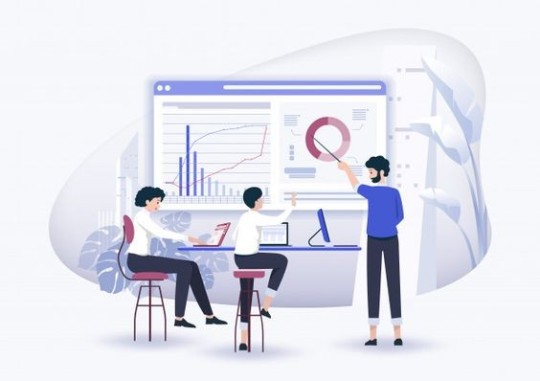
Your call to action must have a deadline for an offer!—-____Visit www.AmericanElite.biz
Be the first five businesses earning between 10M to 50M per year that SET UP a FREE BUSINESS DIGITAL & PROFIT MAXIMIZATION CONSULTATION & receive a FREE CUSTOMIZED LOGO & BRANDING CONSULTATION WORTH $1000.00!
(Offer good until January 31, 2024)
BE THE FIRST FIVE READERS TO RECEIVE YOUR FREE CUSTOMIZED BUSINESS LOGO & FREE BRANDING CONSULTATION WORTH $1000 NOW!
Visit: www.AmericanElite.Biz Offer Good Until January 31. 2024
Strategies for Making Surgical Centers More Profitable with Technology
Overview:
Surgical centers are utilizing technology advancements to improve patient care and increase operational efficiency and, ultimately, profitability in the quickly changing healthcare industry. In order to successfully strike a compromise between state-of-the-art medical care and long-term financial viability, this article examines strategic techniques that use technology to increase surgical center profits.
Using 3D Imaging for Accurate Diagnostics:
By integrating 3D imaging technology, surgeons may now see anatomical features with never-before-seen detail, improving diagnostic precision. This enhances surgical planning efficiency while simultaneously improving patient outcomes.
Intraoperative Imaging Devices:
During surgery, real-time imaging gives doctors instantaneous insights. This technical breakthrough optimizes resource usage by reducing the need for follow-up surgeries and guaranteeing accuracy throughout procedures.
Little-Invasive Techniques:
Minimally invasive surgery can be performed with the use of robotics, which shortens hospital stays and recovery times. In addition to being favored by patients, these procedures also result in higher patient turnover and more financial success.
Robotics under Surgeon Control:
Using robotic technologies under the supervision of surgeons improves operating precision. Surgeons are regarded for their superior surgical skills and are able to perform complex treatments with higher accuracy, which improves patient satisfaction.
Digital Documentation for Optimal Performance:
EHR systems ensure accurate documentation, minimize paperwork, and digitize patient records to expedite administrative processes. Staff members can concentrate on patient care thanks to the time savings that result from this efficiency, which also boosts overall productivity.
Automated Workflow Management and Scheduling:
Allocating surgery suites, personnel, and equipment is optimized when automated scheduling is used through EHR systems. This not only shortens patient wait times but also increases the surgical center's ability to do treatments, which eventually boosts profitability.
Portals for Patients to Access Information:
Putting patient portals into place improves engagement and communication. Patients will be more informed and happier as a result of having access to information, pre-operative instructions, and post-operative care data.
Handy Mobile Applications:
Creating smartphone apps for patients facilitates communication and adds convenience. Through the ability to schedule appointments and get medical records, mobile apps improve patient satisfaction and foster enduring loyalty.
In summary:
By utilizing technology, surgical centers can position themselves for more revenue while also guaranteeing better patient care. Surgical centers may establish a smooth and effective operation that generates revenue by carefully combining robotic-assisted surgery, EHR systems, telemedicine, data analytics, and patient-centric technologies. Surgical centers may become lucrative and sustainable in the digital era by combining technology and surgical quality; this is more than just a business decision.
Your call to action must have a deadline for an offer!—-____Visit www.AmericanElite.bizBe the first five businesses earning between 10M to 50M per year that SET UP a FREE BUSINESS DIGITAL & PROFIT MAXIMIZATION CONSULTATION & receive a FREE CUSTOMIZED LOGO & BRANDING CONSULTATION WORTH $1000.00!(Offer good until January 31, 2024)
BE THE FIRST FIVE READERS TO RECEIVE YOUR FREE CUSTOMIZED BUSINESS LOGO & FREE BRANDING CONSULTATION WORTH $1000 NOW!
Visit: www.AmericanElite.Biz Offer Good Until January 31. 2024
#packaging#poster#programming#3d printing#software engineering#machine learning#rpg maker#typography#python#technology#software#medicine#consulting services#cosmetics
0 notes
Text
i helped* write a new physics textbook and it has a cool (and free) website: softmatterbook.online
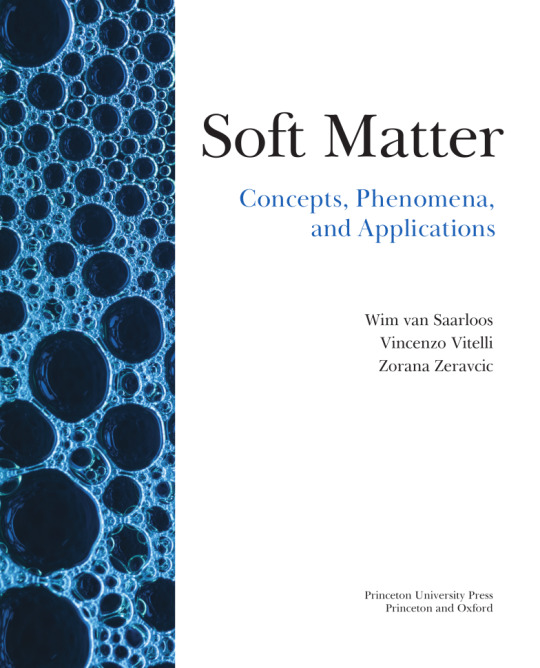
*a little bit. The vast majority of the book was written by van Saarloos, Vitelli, and Zeravcic, but a whole bunch of people contributed little bits of writing (myself included) and are credited in the preface.
This book is an accumulation of some of the most fundamental results in soft matter physics, many of which were first discovered or derived very recently. The website hosts a bunch of extra resources (videos, notes, demos, etc.) sorted by the chapters of the book:
Fluid Dynamics
Elasticity
Brownian Motion
Colloids
Polymers
Liquid Crystals
Interfaces, Surfaces, & Membranes
Pattern Formation out of Equilibrium
Active Matter
From Designing Matter to Mimicking Life
It also lists a whole bunch of labs all around the world that are studying the sorts of systems described in the book, as well as mailing lists you can sign up for, conferences, workshops, youtube channels, and software packages. I'm absolutely biased (see below) but I think it's a really great resource for anybody interested in soft matter!
I spent the first year of my PhD helping to put this thing together. I translated research papers into problems, hunted for typos, and wrote most of the solutions in the instructor's manual. I don't make any money off the book sales (my PI told me they made it available for as cheap of a price as the publisher would allow), but my PhD stipend was funded for the year to work on this thing instead of having to TA.
I was ridiculously lucky to get the chance to work on this thing, even if at times it felt like learning how the academic sausage gets made.
77 notes
·
View notes
Note
Hello there! I hope you don’t mind me just dropping into your asks like this, but by all means def feel free to just delete this if so, it is kind of a weird ask.
This is the anon from the computer blog asking about a private laptop for collage! After doing (a small amount of) research into Linux, one thing that’s super confusing to me, is… how does one know which distro to use? You mentioned in the replies of the post that you use Ubuntu Linux, which seems to be one of the more popular ones. Would you recommend — and if so, why? Is it good for privacy, do you think? The best? Does the user need to have a good deal of experience with computers to keep it running? (I’ve never used a laptop before but I don’t mind trying to learn stuff)
Also this is an EXTREMELY stupid question my apologies, but how….. exactly do you put Linux on a laptop? OP from my ask said to buy a laptop with no OS but is that something you can do? I’d think so, since 0P works with computer and stuff as their job, but Reddit says that it’s not really possible and that you should just “buy like a Windows laptop and scrap the software”??? Is that… correct? How did you install Linux on your laptop — did y ou have to remove software off it or did you, as OP says, manage to find a laptop with no OS?
Again, feel free to ignore if you don’t wanna put in the time/effort to reply to this, I absolutely don’t mind — it’s a lot of stuff I’m asking and you didn’t invite it all, so ofc feel free to delete the ask if you’d like!
ha, you've zeroed in on one of the big reasons Linux is kind of a contrarian choice for me to recommend: the wild proliferation of distros, many of them hideously complex to work with. luckily, the fact that most of them are niche offshoots created by and for overly-technical nerds makes the choice easier: you don't want those. you want one of the largest, best-supported, most popular ones, with a reputation for being beginner-friendly. the two biggies are Ubuntu and Linux Mint; i'd recommend focusing your research there.
this isn't JUST a popularity-contest thing: the more people use it, the more likely you are to find answers if you're having trouble or plugging a weird error message into google, and the greater the variety of software you'll find packaged for easy install in that distro. some combination of professional and broad-based community support means you'll find better documentation and tutorials, glitches will be rarer and get fixed faster, and the OS is less likely to be finicky about what hardware it'll play nice with. the newbie-friendly ones are designed to be a breeze to install and to not require technical fiddling to run them for everyday tasks like web browsing, document editing, media viewing, file management, and such.
info on installation, privacy, personal endorsement, etc under the cut. tl;dr: most computers can make you a magic Linux-installing USB stick, most Linuces are blessedly not part of the problem on privacy, Ubuntu i can firsthand recommend but Mint is probably also good.
almost all Linux distros can be assumed to be better for privacy than Windows or MacOS, because they are working from a baseline of Not Being One Of The Things Spying On You; some are managed by corporations (Ubuntu is one of them), but even those corporations have to cater to a notoriously cantankerous userbase, so most phoning-home with usage data tends to be easy to turn off and sponsored bullshit kept minimally intrusive. the one big exception i know of is Google's bastard stepchild ChromeOS, which you really don't want to be using, for a wide variety of reasons. do NOT let someone talk you into installing fucking Qubes or something on claims that it's the "most private" or "most secure" OS; that's total user-unfriendly overkill unless you have like a nation-state spy agency or something targeting you, specifically.
how to install Linux is also not a dumb question! back in the day, if you wanted to, say, upgrade a desktop computer from Windows 95 to Windows 98, you'd receive a physical CD-ROM disc whose contents were formatted to tell the computer "hey, i'm not a music CD or a random pile of backup data or a piece of software for the OS to run, i want you to run me as the OS next time you boot up," and then that startup version would walk you through the install.
nowadays almost anyone with a computer can create a USB stick that'll do the same thing: you download an Ubuntu installer and a program that can perform that kind of formatting, plug in the USB stick, tell the program to put the installer on it and make it bootable, and then once it's done, plug the USB stick into the computer you want to Linuxify and turn it on.
Ubuntu has an excellent tutorial for every step of the install process, and an option to do a temporary test install so you can poke around and see how you like it without pulling the trigger irreversibly: https://ubuntu.com/tutorials/install-ubuntu-desktop
having a way to create a bootable USB stick is one reason to just get a Windows computer and then let the Linux installer nuke everything (which i think is the most common workflow), but in a pinch you can also create the USB on a borrowed/shared computer and uninstall the formatter program when you're done. i don't have strong opinions on what kind of laptop to get, except "if you do go for Linux, be sure to research in advance whether the distro is known to play nice with your hardware." i'm partial to ThinkPads but that's just, like, my opinion, man. lots of distros' installers also make it dead simple to create a dual-boot setup where you can pick between Windows and Linux at every startup, which is useful if you know you might have to use Windows-only software for school or something. keep in mind, though, that this creates two little fiefdoms whose files and hard-disk space aren't shared at all, and it is not a beginner-friendly task to go in later and change how much storage each OS has access to.
i've been using the distro i'm most familiar with as my go-to example throughout, but i don't really have a strong opinion on Ubuntu vs Mint, simply because i haven't played around with Mint enough to form one. Ubuntu i'll happily recommend as a beginner-friendly version of Linux that's reasonably private by default. (i think there's like one install step where Canonical offers paid options, telemetry, connecting online accounts, etc, and then respects your "fuck off" and doesn't bug you about it again.) by reputation, Mint has a friendlier UI, especially for people who are used to Windows, and its built-in app library/"store" is slicker but offers a slightly more limited ecosystem of point-and-click installs.
(unlike Apple and Google, there are zero standard Linux distros that give a shit if you manually install software from outside the app store, it's just a notoriously finicky process that could take two clicks or could have you tearing your hair out at 3am. worth trying if the need arises, but not worth stressing over if you can't get it to work.)
basic software starter-pack recommendations for any laptop (all available on Windows and Mac too): Firefox with the uBlock Origin and container tab add-ons, VLC media player, LibreOffice for document editing. the closest thing to a dealbreaking pain in the ass about Linux these days (imo) is that all the image and video editing software i know of is kinda janky in some way, so if that's non-negotiable you may have to dual-boot... GIMP is the godawfully-clunky-but-powerful Photoshop knockoff, and i've heard decent things about Pinta as a mid-weight image editor roughly equivalent to Paint.net for Windows.
49 notes
·
View notes